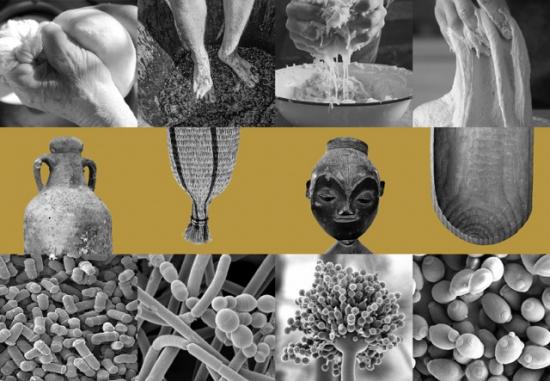End Date: Saturday, March 14, 2026

Although microbes are the most abundant and diverse organisms on our planet, anthropology has paid little attention to the complex web of interactions between humans and these largely inconspicuous, yet influential living beings. Growing interest in the evolutionary dynamics of humans and microbes, advancements in research methodologies, and the emerging field of ethnomicrobiology are shedding new light on the symbiotic creativity of human and microbial cultures.
Perhaps the most visible and enduring manifestation of human-microbe relations is fermentation. A universally adopted technique, fermentation has been employed for millennia in the creation, enhancement, and preservation of all manner of foods and beverages. People across the world and throughout time have developed specialized tools, containers, facilities, and processes to make fermented products from local varieties of fruits, vegetables, tubers, legumes, grains, meats, seafood, and dairy. Countless human cultures have embraced traditional fermented foods and beverages as integral expressions of identity and kinship, and employ them in communal rituals, as social lubricants, healing elixirs, and conduits to the divine.
Drawing from the Maxwell Museum’s collections, Entangled Cultures presents diverse global examples of traditional vessels used in the creation and consumption of fermented foods and beverages. The exhibit begins with an overview of how fermentation likely served as a catalyst for human ancestors to develop smaller digestive systems, larger brains, and ultimately expand into new environments. It also retraces the origins of many now ubiquitous ferments, such as wine, beer, bread, and cheese. Reflections on the ever-changing nature of human-microbe relations are woven throughout the exhibit, which concludes with a peek into our fermented futures, including novel adaptations to climate change and possibilities for interspecies flourishing in the post-Anthropocene world.
Opening Reception: Please join us on Saturday, March 8, 2025, from 2 pm to 4 pm for the opening reception. A wide selection of fermented foods and beverages from local producers will be available to sample.
Contact: For media inquiries, please contact the Maxwell Museum’s Curator of Public Programs Julián Antonio Carrillo (jac123@unm.edu), or Curator of Exhibits, Toni Gentilli (tgentilli@unm.edu).
Share your fermentation recipes with us to create a community cookbook!
End Date: Saturday, December 6, 2025
![Two sites of former hogans. Fartherest [sic] occupied this year, nearest one occupied this year. Red Lake (Tolani Lakes, Leupp, Arizona)](https://maxwellmuseum.unm.edu/sites/default/files/exhibits/temporary/Key%20Image_Low%20Res.jpg)
Two sites of former hogans. Fartherest [sic] occupied this year, nearest one occupied this year. Red Lake (Tolani Lakes, Leupp, Arizona), 1935-1936. Milton Snow. Reproduction of gelatin silver print, Maxwell Museum of Anthropology Archives, 87.45.116.
Using the photograph as a site of inquiry, this exhibition examines the impact of U.S. Indian Commissioner John Collier’s brutal Navajo Livestock Reduction Program on Diné communities and homelands.
Imposed upon Navajo people in the 1930s, this federal program proposed to eliminate over half of Diné livestock herds. Against the backdrop of the Dust Bowl and the Hoover Dam, livestock reduction was an extreme response to reports of over-grazing throughout Diné Bikéyah, the Navajo homeland. Collier’s policies were carried out in ignorance of Diné land management practices and community needs. Imprisoned for resisting, Diné people were forced to watch their livelihoods decimated as their sacred animals were taken from them. Livestock reduction resulted in widespread, harmful, and long-term sociocultural, environmental, economic, and political changes throughout Diné Bikéyah.
Diné communities resisted livestock reduction policies. They saw their domestic animals as gifts from the Holy People, who offered them as the foundation for the Diné way of life. As a result of Collier’s tool of colonial control, Navajo people were no longer able to care for their land, their communities, and their herds in the ways they always had. In reflecting on this period, Marilyn Help (Diné) says, “You people...are heartless. You have now killed me. You have cut off my arms. You have cut off my legs. You have taken my head off. There is nothing left for me.”
Hired by the Navajo Service in 1937, non-Native photographer Milton Snow (1905–1986) was instructed to document the the federal government’s supposedly well-intentioned program to address “the Navajo problem.” Over the course of twenty years, Snow produced thousands of images of Diné people, homes, and landscapes, all of which were intended to provide proof that federal technologies were in fact working to “rehabilitate” Navajo lands and lives. Instead, Snow’s photographs show us radically harmed and altered communities, landscapes, and homes. We see the construction of dams, mines, and imposed grazing and agricultural practices; and newly formed political, educational, and socioeconomic organizations, all of which point to the pervasive, oppressive nature of American colonial administration.
By placing Snow’s images in conversation with a selection of archival documents and contemporary photographs, this exhibition foregrounds Diné perspectives on the intersecting and ongoing legacies of both photography and American colonialism.
University Showcase Interview with the exhibtion curators on KUNM from May 13, 2024.